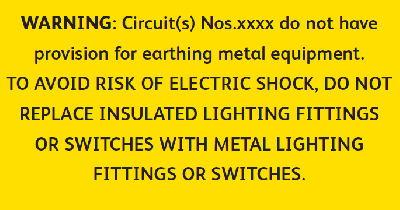Difference between revisions of "Lighting Circuits Without an Earth"
ARWadsworth (talk | contribs) |
(Added section titles, links and a bit of general tarting) |
||
| Line 1: | Line 1: | ||
| − | + | ==Background== | |
| − | Many lighting circuits (usually | + | Many lighting circuits (usually installed pre 1966) are still in use that have no earth (aka Circuit Protective Conductor (CPC)). |
Whilst the rewiring of these circuits is the preferable solution, for many people the cost of installation and redecorating can be prohibitive. | Whilst the rewiring of these circuits is the preferable solution, for many people the cost of installation and redecorating can be prohibitive. | ||
| + | ==Reducing risk== | ||
If a rewire is not an option then the following steps should be taken for safety reasons | If a rewire is not an option then the following steps should be taken for safety reasons | ||
| − | + | :# Class I light fittings and metal accessories should be replaced with Class II (plastic/insulated) fittings | |
| + | :# Insulation Resistance Test. The circuit should be tested between the line conductor (line and neutral connected together) and the earth terminal of the consumer unit. The resistance should be at least 1 Megohm. If the resistance is less that 1 Megohm the circuit must have additional RCD protection. The test should also be repeated between the line conductor and any exposed conductive part of the circuit (eg the screws for a lightswitch with a metal backbox). Again if the readings are less than 1 Megohm then additional RCD protection will be required. | ||
| + | :# RCD protection. It is advisable to have 30mA RCD protection on lighting circuits that have no cpc and essential if the resistance readings are lower than 1 Megohm. | ||
| + | :# 2 and 3 pin sockets. Any 2 or 3 pin sockets connected to the lighting circuit that may be used for portable equipment should be disconnected. | ||
| + | :# A warning notice similar to the one below should be fixed on or adjacent to the CU or fusebox: | ||
| + | [[Image:Warning-notice-lights.png|center|400px]] | ||
| − | + | ==Potential problems== | |
| − | + | ===Extending the circuit=== | |
| + | Not having a cpc on a lighting circuit makes it impossible to safely extend the circuit should you require extra lighting points. One viable workaround to add lighting points, is to feed them via another circuit that does have a CPC, via an fused connection unit (with appropriate fuse). | ||
| − | + | ===Consumer unit upgrades=== | |
| + | Many electricians may also refuse to swap a [[fusebox]] for a [[CU]] unless the old lighting circuit is also rewired. | ||
| − | |||
| + | == See Also == | ||
| + | * [[Earthing Types]] | ||
| + | * [[TT Earthing]] | ||
| + | * [[Ufer Earthing]] | ||
| + | * [[Electrical Circuit Faults]] | ||
| + | * [[Changing a consumer unit]] | ||
| − | + | ||
| + | [[Category:Electrical]] | ||
| + | [[Category:Safety]] | ||
Revision as of 20:31, 26 February 2011
Background
Many lighting circuits (usually installed pre 1966) are still in use that have no earth (aka Circuit Protective Conductor (CPC)). Whilst the rewiring of these circuits is the preferable solution, for many people the cost of installation and redecorating can be prohibitive.
Reducing risk
If a rewire is not an option then the following steps should be taken for safety reasons
- Class I light fittings and metal accessories should be replaced with Class II (plastic/insulated) fittings
- Insulation Resistance Test. The circuit should be tested between the line conductor (line and neutral connected together) and the earth terminal of the consumer unit. The resistance should be at least 1 Megohm. If the resistance is less that 1 Megohm the circuit must have additional RCD protection. The test should also be repeated between the line conductor and any exposed conductive part of the circuit (eg the screws for a lightswitch with a metal backbox). Again if the readings are less than 1 Megohm then additional RCD protection will be required.
- RCD protection. It is advisable to have 30mA RCD protection on lighting circuits that have no cpc and essential if the resistance readings are lower than 1 Megohm.
- 2 and 3 pin sockets. Any 2 or 3 pin sockets connected to the lighting circuit that may be used for portable equipment should be disconnected.
- A warning notice similar to the one below should be fixed on or adjacent to the CU or fusebox:
Potential problems
Extending the circuit
Not having a cpc on a lighting circuit makes it impossible to safely extend the circuit should you require extra lighting points. One viable workaround to add lighting points, is to feed them via another circuit that does have a CPC, via an fused connection unit (with appropriate fuse).
Consumer unit upgrades
Many electricians may also refuse to swap a fusebox for a CU unless the old lighting circuit is also rewired.
